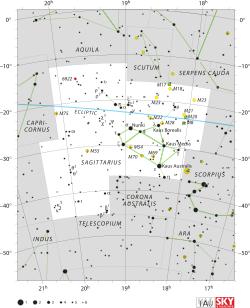Phi Sagittarii
| Observation data Epoch J2000 Equinox J2000 |
|
|---|---|
| Constellation | Sagittarius |
| Right ascension | 18h 45m 39.38610s[1] |
| Declination | –26° 59′ 26.7944″[1] |
| Apparent magnitude (V) | 3.17[2] |
| Characteristics | |
| Spectral type | B8.5 III[3] to B7 IV[4] |
| U−B color index | –0.36[5] |
| B−V color index | –0.11[5] |
| Astrometry | |
| Radial velocity (Rv) | +21.5[2] km/s |
| Proper motion (μ) | RA: +50.61[1] mas/yr Dec.: +1.22[1] mas/yr |
| Parallax (π) | 13.63 ± 0.19[1] mas |
| Distance | 239 ± 3 ly (73 ± 1 pc) |
| Details | |
| Mass | 4–4.2[6] M☉ |
| Radius | 4.8[6] R☉ |
| Luminosity | 475[6] L☉ |
| Temperature | 14,990[4] K |
| Rotational velocity (v sin i) | 35[7] km/s |
| Age | 1.65 × 108[6] years |
| Other designations | |
Phi Sagittarii (Phi Sgr, φ Sagittarii, φ Sgr) is a star in the southern constellation of Sagittarius. With an apparent visual magnitude of 3.17,[2] it is the ninth brightest star in the constellation and is readily visible to the naked eye. Parallax measurements place it at a distance of roughly 239 light-years (73 pc) from the Earth.[1]
The stellar classification of this star has been rated at B8.5 III[3] and B7 IV,[4] with a luminosity class of III indicating it is a giant star, while a class of IV suggests it is still a subgiant star. Both represent stages in the evolution of a star after it has exhausted the hydrogen at its core. This energy is being radiated from the star's outer envelope at an effective temperature of 14,990 K,[4] which produces the blue-white hue typical of B-type stars.[9]
In the past, this star catalogued as a spectroscopic binary and a companion was apparently detected through lunar occultation.[10] However, it is most likely a solitary star[6][11] and any nearby stars are merely optical companions.
Name and etymology
- This star, together with :
- γ Sgr, δ Sgr, ε Sgr, ζ Sgr, λ Sgr, σ Sgr and τ Sgr comprising the asterism Teapot.[12][13]
- σ Sgr, ζ Sgr, χ Sgr and τ Sgr were Al Naʽām al Ṣādirah (النعم السادرة), the Returning Ostriches.[14] According to the catalogue of stars in the Technical Memorandum 33-507 - A Reduced Star Catalog Containing 537 Named Stars, Al Naʽām al Ṣādirah or Namalsadirah was originally the title for four stars: φ Sgr as Namalsadirah I, τ Sgr as Namalsadirah II, χ1 Sgr as Namalsadirah III and χ2 Sgr as Namalsadirah IV (except σ Sgr and ζ Sgr) .[15]
- In the catalogue of stars in the Calendarium of Al Achsasi al Mouakket, this star was designated Aoul al Sadirah, which was translated into Latin as Prima τού al Sadirah, meaning first returning ostrich.[16]
- In Chinese, 斗 (Dǒu), meaning Dipper, refers to an asterism consisting of φ Sagittarii, λ Sagittarii, μ Sagittarii, σ Sagittarii, τ Sagittarii and ζ Sagittarii. Consequently, φ Sagittarii itself is known as 斗宿一 (Dǒu Sù yī, English: the First Star of Dipper.)[17]
References
- ↑ 1.0 1.1 1.2 1.3 1.4 1.5 Lua error in package.lua at line 80: module 'strict' not found.
- ↑ 2.0 2.1 2.2 Lua error in package.lua at line 80: module 'strict' not found.
- ↑ 3.0 3.1 Lua error in package.lua at line 80: module 'strict' not found.
- ↑ 4.0 4.1 4.2 4.3 Lua error in package.lua at line 80: module 'strict' not found.
- ↑ 5.0 5.1 Lua error in package.lua at line 80: module 'strict' not found.
- ↑ 6.0 6.1 6.2 6.3 6.4 Lua error in package.lua at line 80: module 'strict' not found.
- ↑ Lua error in package.lua at line 80: module 'strict' not found.
- ↑ Lua error in package.lua at line 80: module 'strict' not found.
- ↑ Lua error in package.lua at line 80: module 'strict' not found.
- ↑ Lua error in package.lua at line 80: module 'strict' not found.
- ↑ Lua error in package.lua at line 80: module 'strict' not found.
- ↑ Lua error in package.lua at line 80: module 'strict' not found.
- ↑ skywatchers Archived May 17, 2007 at the Wayback Machine
- ↑ Lua error in package.lua at line 80: module 'strict' not found.
- ↑ Jack W. Rhoads - Technical Memorandum 33-507-A Reduced Star Catalog Containing 537 Named Stars, Jet Propulsion Laboratory, California Institute of Technology; November 15, 1971
- ↑ Lua error in package.lua at line 80: module 'strict' not found.
- ↑ (Chinese) AEEA (Activities of Exhibition and Education in Astronomy) 天文教育資訊網 2006 年 5 月 11 日
